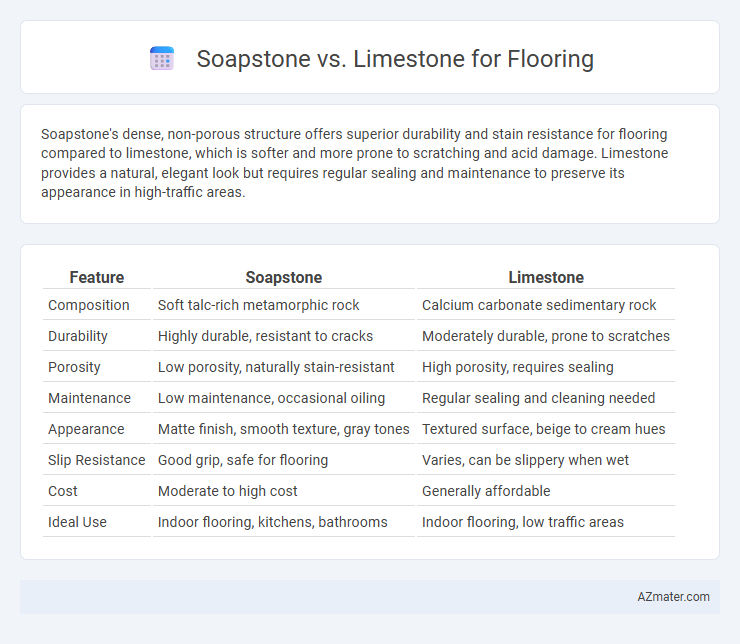Soapstone's dense, non-porous structure offers superior durability and stain resistance for flooring compared to limestone, which is softer and more prone to scratching and acid damage. Limestone provides a natural, elegant look but requires regular sealing and maintenance to preserve its appearance in high-traffic areas.
Table of Comparison
| Feature | Soapstone | Limestone |
|---|---|---|
| Composition | Soft talc-rich metamorphic rock | Calcium carbonate sedimentary rock |
| Durability | Highly durable, resistant to cracks | Moderately durable, prone to scratches |
| Porosity | Low porosity, naturally stain-resistant | High porosity, requires sealing |
| Maintenance | Low maintenance, occasional oiling | Regular sealing and cleaning needed |
| Appearance | Matte finish, smooth texture, gray tones | Textured surface, beige to cream hues |
| Slip Resistance | Good grip, safe for flooring | Varies, can be slippery when wet |
| Cost | Moderate to high cost | Generally affordable |
| Ideal Use | Indoor flooring, kitchens, bathrooms | Indoor flooring, low traffic areas |
Introduction: Choosing the Right Stone for Flooring
Soapstone and limestone both offer unique qualities for flooring, with soapstone known for its durability, non-porous surface, and resistance to stains and heat, making it ideal for areas with high foot traffic. Limestone provides a softer, more natural aesthetic with a range of neutral tones, but requires more maintenance due to its porous nature and susceptibility to scratches and stains. Selecting the appropriate stone depends on balancing aesthetic preferences with durability requirements and maintenance willingness.
What is Soapstone? Key Characteristics
Soapstone is a metamorphic rock primarily composed of talc, giving it a soft, smooth texture and a soapy feel, which makes it easy to carve and shape for flooring. Its key characteristics include high heat resistance, natural non-porosity that resists stains, and excellent durability against scratches and chips. Soapstone floors offer a unique, matte finish with subtle veining, providing both aesthetic appeal and low maintenance compared to limestone.
What is Limestone? Key Characteristics
Limestone is a sedimentary rock primarily composed of calcium carbonate, often formed from marine organisms' skeletal fragments. Its key characteristics include a relatively soft texture, a light color palette ranging from white to beige, and natural porosity, which requires proper sealing for flooring durability. This stone's natural elegance and ease of shaping make it a popular choice for interior flooring, although it is less resistant to scratches and acid compared to harder stones like soapstone.
Appearance: Visual Differences Between Soapstone and Limestone
Soapstone flooring exhibits a smooth, matte finish with subtle veining patterns in shades of gray, green, or bluish tones, creating an elegant and natural look. Limestone flooring, characterized by a softer, porous texture, displays warm earth tones such as beige, cream, or light brown with more consistent coloration and occasional fossils or shell impressions. The visual appeal of soapstone offers a sleek, contemporary aesthetic, while limestone provides a rustic, classic charm with its granular surface and natural variations.
Durability: Scratch and Impact Resistance
Soapstone offers superior scratch resistance due to its dense, non-porous composition, making it highly durable for high-traffic flooring areas. Limestone, while elegant, is softer and more prone to scratches and chips under impact, requiring careful maintenance. The inherent toughness of soapstone ensures long-lasting performance and minimal wear in comparison to the more delicate limestone surfaces.
Maintenance and Cleaning Requirements
Soapstone flooring demands minimal maintenance due to its dense, non-porous nature that resists staining and scratches, requiring only occasional resealing with mineral oil to maintain its rich appearance. Limestone, being more porous and softer, necessitates regular sealing to prevent moisture absorption, staining, and erosion, alongside gentle cleaning with pH-neutral products to avoid surface damage. Both materials benefit from routine sweeping and wiping, but soapstone offers superior durability and ease in long-term upkeep compared to limestone.
Slip Resistance and Safety Considerations
Soapstone offers superior slip resistance compared to limestone due to its naturally textured surface, making it a safer option for flooring in wet or high-traffic areas. Limestone, while aesthetically pleasing with its smooth and polished finish, tends to be more slippery when wet, necessitating additional treatments or mats to enhance safety. Selecting soapstone flooring reduces the risk of slips and falls, contributing to a safer environment in homes or commercial spaces.
Cost Comparison: Soapstone vs. Limestone
Soapstone flooring generally costs between $8 and $15 per square foot, making it a mid-range option known for its durability and heat resistance. Limestone flooring typically ranges from $5 to $10 per square foot, offering a more affordable choice with a softer texture that requires regular sealing and maintenance. The higher cost of soapstone reflects its superior density and minimal upkeep compared to limestone's susceptibility to scratches and stains.
Environmental Impact and Sustainability
Soapstone flooring offers a more environmentally friendly option due to its durability, low porosity, and minimal need for chemical sealants, reducing long-term maintenance emissions compared to limestone. Limestone extraction and processing contribute to higher carbon emissions and habitat disruption, while soapstone's abundant natural deposits require less energy-intensive mining practices. Both materials are natural, but soapstone's longevity and resistance to wear make it a more sustainable choice for eco-conscious flooring projects.
Conclusion: Which Flooring Stone is Best for You?
Soapstone offers superior durability and resistance to stains and heat, making it ideal for high-traffic areas and kitchens, while limestone provides a timeless aesthetic with its unique texture but requires more maintenance due to its softness and porosity. Choosing between soapstone and limestone depends on your lifestyle needs and design preferences, where soapstone serves better for functional durability and limestone excels in elegant, classic appeal. For homeowners prioritizing longevity and low upkeep, soapstone is the best flooring stone, whereas limestone suits those seeking natural beauty and willing to invest in regular care.

Infographic: Soapstone vs Limestone for Flooring
 azmater.com
azmater.com